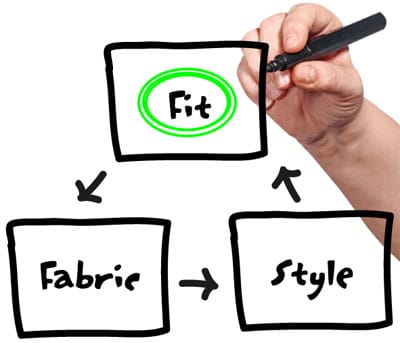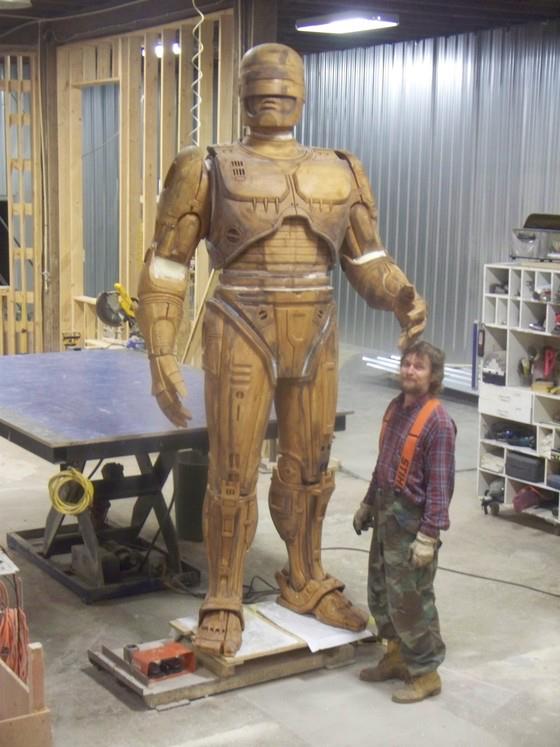 Detroit's Robocop statue, crowdfunded two years ago, is finally taking shape. And it's pretty damned amazing.
Detroit's Robocop statue, crowdfunded two years ago, is finally taking shape. And it's pretty damned amazing. Detroit's Robocop statue, crowdfunded two years ago, is finally taking shape. And it's pretty damned amazing.
Detroit's Robocop statue, crowdfunded two years ago, is finally taking shape. And it's pretty damned amazing. 
The amazing and wonderful Hyperbole and a Half is back, with the long-overdue continuation of the 2011 post on depression. This isn't an entirely upbeat post (as you might expect), but it is every bit as indispensable and smart and great as the previous entries. And it's an ultimately hopeful one, too.
I spent months shut in my house, surfing the internet on top of a pile of my own dirty laundry which I set on the couch for "just a second" because I experienced a sudden moment of apathy on my way to the washer and couldn't continue. And then, two weeks later, I still hadn't completed that journey. But who cares - it wasn't like I had been showering regularly and sitting on a pile of clothes isn't necessarily uncomfortable. But even if it was, I couldn't feel anything through the self hatred anyway, so it didn't matter. JUST LIKE EVERYTHING ELSE.
Slowly, my feelings started to shrivel up. The few that managed to survive the constant beatings staggered around like wounded baby deer, just biding their time until they could die and join all the other carcasses strewn across the wasteland of my soul.
I couldn't even muster up the enthusiasm to hate myself anymore.
Hyperbole and a Half: Depression Part Two ![]()
Let’s just be honest: style, for men, is a hard thing to grasp. It’s especially hard when buying new clothes. We always forget our sizes, we don’t know how things are supposed to fit, and we can never figure out what matches or looks good. Sometimes what we buy ends up sitting in the closet because we don’t like the way it fits or looks when we wear it. In short, shopping for clothes can feel like a confusing or frustrating process. But it doesn’t have to be. What if I told you there was a way to simplify style? If you can focus on the easy-to-remember tips in this article, you’ll be able to walk into any store with a clear idea of what to buy, and you’ll walk out and into the world with confidence in how you look.
My favorite tool for selecting clothes that look good on you is the Style Pyramid.
It’s a simple three-step rubric: Fit, Fabric, and Style.
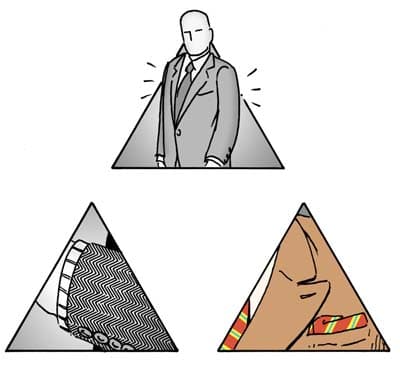
Fit, Fabric, & Style – The Style Pyramid
A piece of clothing that doesn’t meet all three criteria is a piece of clothing you’re better off not wearing.
- Fit sits at the top of the pyramid. Everything else comes from it. If a garment doesn’t fit well, none of its other characteristics matter — it’s not going to look good on you. Fit should always be your first stopping point when you consider a purchase.
- Fabric is key in determining the quality of a piece of clothing. If you’re not satisfied with the raw material, you’re not going to be all that satisfied with the finished product. It’s less of an absolute barrier than fit — you can have many degrees of quality, whereas fit mostly breaks down into “good” and “bad.” That said, fabric is still a crucial consideration.
- Style is aboutyour own personal taste and the image you want to present. If something fits and is well made, but doesn’t give you the look you want, it’s still not a good purchase.
Work your way through the pyramid in this order when you’re thinking about buying clothes. If something doesn’t fit, stop there. If it fits, but it seems cheaply made, skip it. And if it fits and is of good quality, but doesn’t feel right for your style, wait for something more suited to your tastes.
When all three intersect — then it’s time to buy.
Fit
Fit is at the top of the pyramid for a reason.
The way your clothes sit on your body affect the way they look to others more than anything else about them.
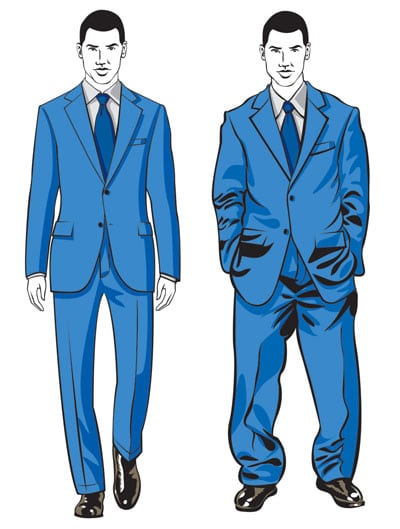
Most men wear a suit that is two sizes too large. Fit matters – a lot.
Now, that doesn’t mean that you can look sharp-dressed in totally inappropriate clothes just because they fit well. A custom-tailored banana suit is still a banana suit. But it does mean that the best suit in the world can look awful on someone it’s not fitted for.
Think of it as the ultimate fashion triage: does the item in question fit your body? If not, skip it. It’s not worth wearing, no matter what its other merits might be.
The most general guideline for a good fit is that it should sit close to your skin without pinching or constricting. You shouldn’t feel the cloth tugging when you move around, but you also shouldn’t have any loose billowing or sagging.
In general, you should always be able to slip one or two fingers between the clothing and your body. But, every piece of clothing is a little different, so we’ll take a look at how to get the perfect fit for each item separately.
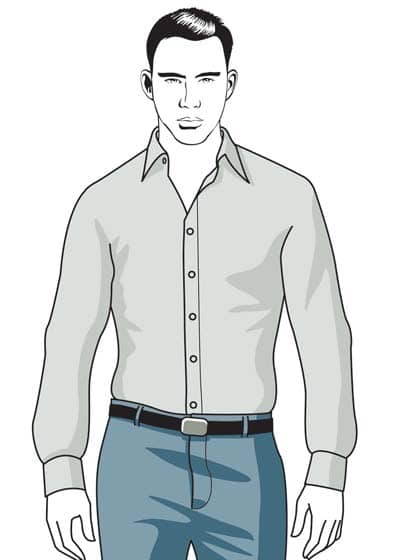
Notice there is no billowing around the waist – beware the muffin top!
Shirt Fit
We’ll assume a collared shirt here so that we cover all the bases, but these guidelines work fine for T-shirts and other non-collared shirts as well. The only real difference is that a shirt you’ll be wearing untucked can be a little looser around the stomach and waist without it being noticeable.
- The shirt collar should rest on your neck but not pinch it. In the case of a dress shirt, this should be with the collar button fastened, as if you were going to wear a necktie. If you can’t do that without feeling constricted, or if there’s a gap between the cloth and your neck, the fit is off.
- The shoulder seams should end right where your shoulders do — the point where the vertical plane of your bicep intercepts the horizontal plane of your shoulder. If they don’t reach all the way, or if you’ve got part of the seam hanging down your bicep, it’s a no-go. This is a tough one for a tailor to adjust, so if the shoulder fit isn’t good to begin with, it’s usually not worth buying.
- The cuffs should be long enough to cover the large bone in your wrist (the one directly above your pinky finger). If it’s shorter than that it won’t show properly beyond a suit or sports jacket sleeve. A straight sleeve or a slightly tapered one are both fine; the taper gives a better fit for most men.
- The hem should fall at least three or four inches past your waist so that it can tuck in completely. If it has “tails” in the front and back, rather than an even hem, make sure the points at the side where the tails come together can tuck in, as well as the longer tails in front and back. You need the whole shirt to tuck, not just the longest parts.
- The waist is where a lot of guys are wearing too much cloth. If your torso tapers, your shirt needs to as well. “Slim fits” can help with that, and it’s a relatively minor adjustment for a tailor to take the shirt in as long as there isn’t too much excess fabric. Get as close a fit as you can manage off the rack and then take it to a tailor if you need more.
Very tall or very short men also need to keep an eye on proportion. It’s easy for a breast pocket to wind up too far up or down your chest, or for a collar to be too short for your neck, especially when you’re having things adjusted. Keep an eye on the details and make sure none of them are “floating” too far from where other men are wearing theirs.

Jacket Fit
A jacket gets a little more space off the body than a shirt, but not much. You’re still trying to avoid gaping open spaces, billowing or hanging cloth, and anything tight enough to pinch or pull.
- Shoulders, like with shirts, have to be well-fitted to begin with. They can’t be adjusted, generally speaking. Like the shirt, the seam should end right where your shoulder does, not before the turn or hanging over it.
- The chest is usually the only numerical measurement for off-the-rack jackets. If it’s taken right, the lapels of your jacket should rest comfortably on your shirt front when you stand, with just enough slack that you can slide a hand into the inner pocket. If the lapels are hanging far enough forward that there’s visible space between the shirt and the jacket in your natural resting pose, it’s too loose.
- The waist affects how the buttons close. They should fasten without any tugging or pressure on the button (it not only looks better, but it’ll also save you buttons popping off). The buttoned sides of the jacket should rest on the shirt beneath them, with the fabrics touching.
- The sleeves should fall just a bit shorter than your shirt sleeves. “A half-inch of linen” is the traditional phrase, but in practice it can vary a bit, so long as the shirt is visibly longer than the jacket you are just fine.
- Length should be at least enough to fall past the curve of your buttocks, rather than resting above it.
Your big warning signs with a jacket are flapping around the lower part, gaps between the jacket and your chest, and of course, any tugging or tightening when you move. Tightness in the arms or sides can also show up as wrinkles where the fabric is pinching.
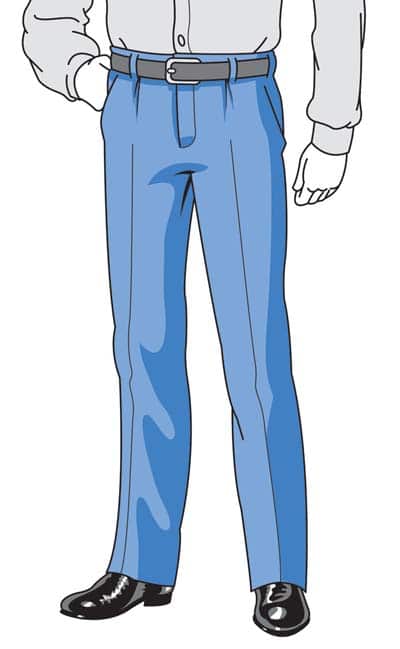
Notice the crotch doesn’t extend down to the middle of the thighs – and the material near the cuff isn’t overly bunched.
Trouser Fit
It’s good to have your shirt and your jacket flat against your skin at most places, but your pants — for obvious reasons — need a touch more room than that. The problem is that most guys go too far and get more room than they need, going from “comfortable” to “saggy.”
- Length is pretty easy to judge; a good fit has the trouser legs ending where they just brush the tops of your shoes, or rest very lightly on them. This is why you need to bring nice shoes along with you when you go shopping. If you’re not touching the shoe leather at all or you’ve got a pile of bunched-up cloth resting on it, the fit is off.
- The waist should be tight enough that you can’t pull the pants all the way off without unbuttoning/unzipping the fly. If it’s digging in or bunching up, it’s too tight. Aim for a fit in between those two. Make sure you’re fitting the waist where you want to wear it — on slacks, that should be up above the hips, at the natural waist. Jeans can be a touch lower, closer to the hips.
- The rise is the distance from the waistband to the place where the seams join in the crotch. It should be as close to your body as comfort allows. A little room for movement is obviously necessary, but a lot of men are wearing pants with two, three, even four or five inches of “sag” in the crotch. Get rid of that! You want enough room for everything you’ve got between your legs, and not much more.
- The seat can vary a bit from brand to brand. There’s no real numerical measurement for it, but it’s another place where you don’t want sag. A loose trouser seat makes your butt look big and soft. Find a brand that hugs your cheeks. You want just enough room that you can slip a wallet in comfortably.
Trouser styles can vary pretty widely, so take these as broad guidelines. Heavier-set men are going to want a little more looseness in the seat than skinny dudes. Just be sure you’re avoiding anything that’s uncomfortably tight or so big you can make the extra fabric sway by swinging your hips around.

Fabric
Judging the quality of fabric at a glance (or a touch) can be challenging.
Product information can sometimes help you here, but it’s just as often misleading — things like “thread count” can be measured in different ways, and some merchants are more honest about it than others.
Inspecting Fabric
In general, if all you have to go on is the actual garment itself, look for the following key qualities:
- 100% construction. If it’s cotton, it should be all cotton. If it’s wool, it should be all wool. A percentage point or two of synthetics may be fine (it’s common in “stretch” clothing, for example, and some wools will come with a small amount of synthetic blended in for mildew resistance), but if the blend goes much lower than 95% base material, it’s probably cheap fabric.
- Appropriate weight. This can vary. If it’s a summer shirt, the weave should be loose and made from fine threads. If it’s a three-season suit, it should be made from sturdy wool, and you should be able to feel the weight in your hands. Avoid anything that seems flimsy, especially in trousers and jackets. You want those to have enough heft that they drape smoothly when you wear them. Too light and they’ll wrinkle and billow.
- Even weave. Check for little knots or imperfections in the surface of the cloth. You don’t want those little bumps, and you definitely don’t want holes or snags. Not all fabrics are smooth — seersucker, for example, is going to be distinctly dimpled — but they should be even. If some bumps are bigger than others, or the spacing is uneven, you’ve got a problem.
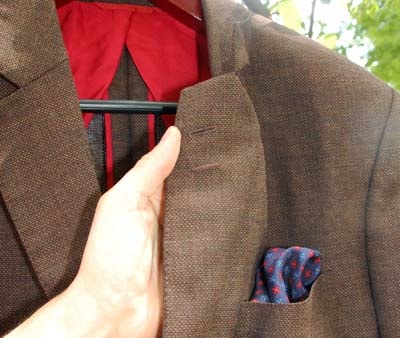
Inspect and look for the details (such as a boutonniere latch on a jacket) – if they are there you can bet the manufacturer did right in places you can’t see.
Inspecting Construction
We say “fabric” because it’s convenient and easy to remember, but it’s worth taking a look at the rest of the construction as well. It’s less common for manufacturers to make shoddy clothing out of good cloth, but it’s not unheard of. Jeans are particularly common offenders; beware of “all USA” denim that’s then made into jeans in the Philippines or Malaysia or somewhere known for lower-quality goods.
Take a look at the details of the construction, whether it’s a fabric item or something as basic as a leather belt:
- Stitching is a good place to check for basic quality assurance. If there are loose thread ends or wobbly stitches, the garment probably wasn’t made with much care or checked very closely. You can safely expect that to result in a lower quality (and lifespan) overall.
- Hemming at the cuffs and edges are another good place to look for unevenness or imperfections. If the hem has wrinkles or folds in it, or is wider in some places than others, you’re not looking at a very well-made garment.
- Materials on the detailing are another good clue. Are the buttons Mother-of-Pearl or plastic? Are the zippers thick brass or flimsy plastic? Are the rivets (blue jeans) evenly-stamped and sturdy? Think twice before buying anything that cuts corners on those small details.
Buying Online
Most of the above tips are only useful when you can hold the garment in your hand. How do you check the fabric (and construction) quality when you’re buying based on nothing but a picture and a written description?
- Stick to brands you trust. If you can, try to avoid making first-time purchases of a brand online. Buying a pair of jeans from a company when you already know you like their quality is fine; buying just because you’ve heard good things is riskier. You could get lucky — but you could also get unlucky.
- Only buy from sites with good return policies. Look at both the refund/exchange policy and the shipping details. Full refunds with no questions asked are best. Free exchanges with the shipping labels included (so that you don’t pay the return shipping) are nearly as good. If the website doesn’t have either of those, you’re taking a chance on spending more money to return something that didn’t work out.
- Construction methods can take a little more research to understand, but it’s worth your time. If you’re buying shoes, know the difference between Goodyear and Blake construction. If you’re looking at jackets, know the difference between fused and unfused canvases, vented and unvented backs, and so on. When the only information you get about a product is a short description or a bullet-pointed list, you want to know what every term in there means.
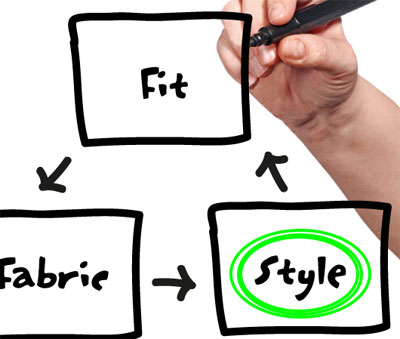
Style
Style is the hardest of these three to define. Does the item say what you want it to? If the answer is yes, then it suits your style.
Wardrobe Interchangeability
Try to think about it in terms of your existing wardrobe. Look at the purchase you’re considering and imagine pairing it with the clothes you already own. If you can come up with a half-dozen different outfits, it’s a safe bet that it goes with your current style.
If you can’t think of any pairings, that’s not grounds for automatic rejection, but it does mean you should think hard about how you’d use the item.
It’s alright to break new ground — in a way, it’s ideal. We should all update our style from time to time. But do it realistically. If you’re going to leave it hanging in your closet for 360 days out of the year, it’s probably not a good investment.
Keep in mind, too, that some new styles may require you to purchase several items at once. Not a problem if you’re willing to do it — just be honest with yourself. Only commit to new looks that you’re pretty sure you’re going to wear regularly and confidently.
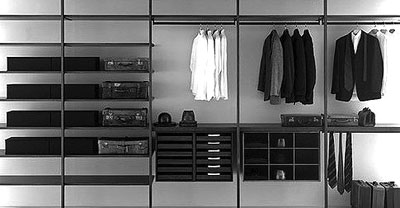
Style Upgrades
A good final question to ask yourself is, “Does this improve my look?”
Some of the best purchases are small, simple things that take your existing wardrobe and make it a little nicer-looking.
A new suit is great. But day to day it’s probably not going to make as much difference as, say, trading your Chuck Taylors for a pair of suede saddle shoes.
Not all style considerations are going to be major. They could be as basic as looking for a new buckle to put on an ordinary brown leather belt. Those little changes are often the biggest bang for your buck in terms of improving your look. Put enough of them together and suddenly you’ve got a “personal style” — without having to buy a whole new wardrobe for hundreds of dollars.
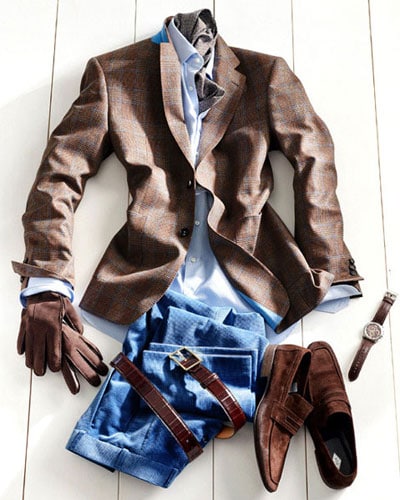
Conclusion
The three-step style pyramid is deliberately simple.
You’re going to have more choices, more questions, and more decisions to make than this overview gives you. But it’s a good starting point — and, more importantly, it’s a good stopping point.
If something fails one of these three basic tests, you probably don’t want it in your wardrobe. So always ask yourself:
- Is the fit good?
- Is the fabric decent?
- Does it suit my style?
If you’ve got a “no” in there anywhere, skip it. There’ll be better clothes some other day.
Video Summary of Post
_____________________
Written By Antonio Centeno
Want My Free Style EBook? Click Here
This is like CSI for geography dorks: you're plopped into a random location on Google Street View and you have to guess where in the world you are. So much fun...you get to say "wait, zoom in, enhance, whoa, back up" to yourself while playing. My top score is 14103...what'd you get? p.s. Using Google in another tab is cheating! (thx, nick)
Tags: gamesgeography Google MapsGoogle Street View






